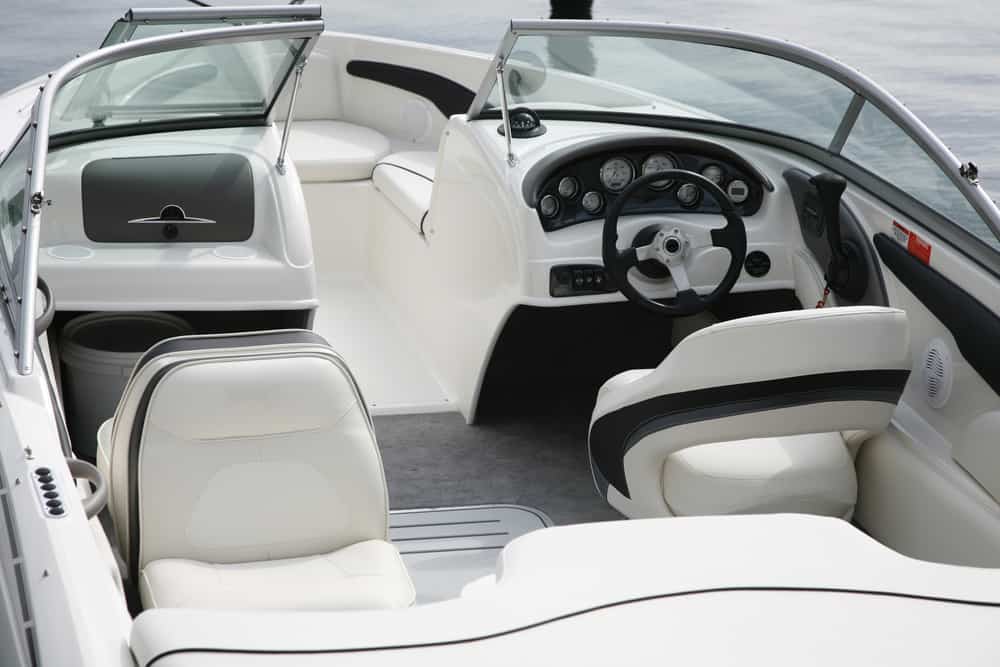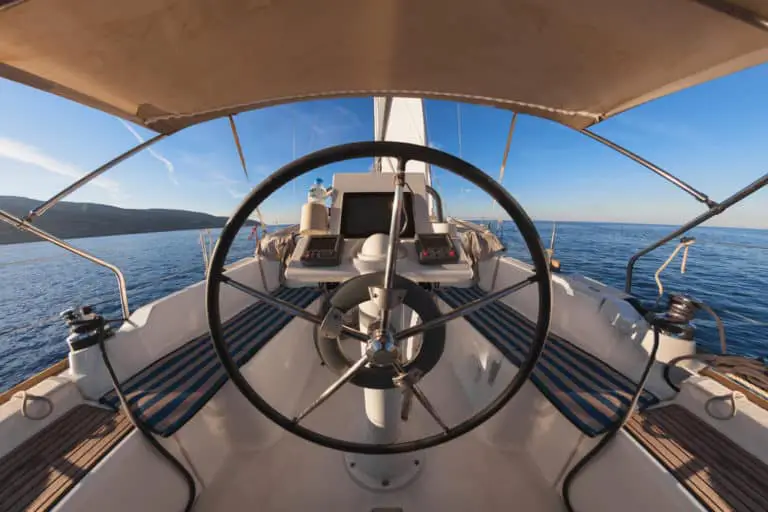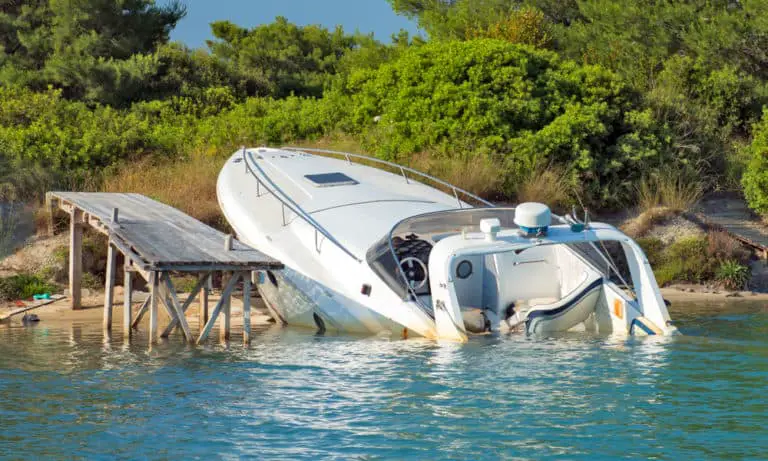How to Clean Boat Seats? (a Practical Guide)

So you’ve bought your first boat and while you think you can master most of it with ease, you keep reading about boat maintenance. Your boat has a number of seats, and maybe you are wondering just how much time you’ll need to set aside to learn how to clean boat seats. This guide will make it almost too easy for you.
- How to Clean Boat Seats?
- Routine Cleaning
- Deep Cleaning
- How to Remove Stains and Mildew?
- What About Magic Eraser?
- What NOT to Do
- What to do About Seat Damage?
- Replacing Vinyl Seats
- How to Care for a Vinyl Boat Seat?
How to Clean Boat Seats?
The best way to clean boat seats is more simple than it may seem at first glance. This can be particularly true if your first glance was at the marine cleaning products section in your local or online retailer.
But you can get the job done with a little bit of gentle dishwashing soap such as Dawn, and some warm freshwater in a bucket. Gently soap your seats, scrub with a soft brush, rinse well, and dry thoroughly.
There are some specialty marine vinyl cleaners that can provide a little more bang for your buck, but if you keep up on your seat cleaning routine the odds that you’ll seriously need them are slim. They are much more effective, however, if you are needing to do a deep clean. For example, on a boat that’s been in storage a while, or maybe buying a used boat that needs a little attention.
Cleaning boat seats should always be done with gentle cleaners and never with full-strength chemicals like bleach or vinegar. Many household chemicals will damage the vinyl, and cause the UV rays to accelerate its deterioration. Use soft bristle brushes that can scrub without damaging the vinyl material, avoid any stiff nylon brushes.
Routine Cleaning
You will need to develop a routine or schedule for cleaning vinyl seats on your boat. For some people, this schedule or routine may need to be much more complex and thorough than some others.
If you are operating an 18’ fishing boat, you may only have a couple of pedestal seats and a bench seat to worry about. On the other hand, if you are spending several days at a time on your pleasure cruiser, you may have a dozen seats or more to worry about keeping clean, dry, and properly sealed.
For doing your normal vinyl seat maintenance, you can make your own soap solution with dish soap and warm water in a pinch. It will clean boat vinyl but won’t do big jobs or deep cleaning.
You may want to keep a bottle of WEST MARINE Vinyl Cleaner, 22oz. on hand to spray down after a long weekend on the water. If you need more supplies, this Boat Care Kit with 3 1/2 Gallon Bucket comes with everything you need for seats and more.
Those with fabric seats need to make sure they are keeping them treated as well. This is very important since the fabric will lose its mildew-proofing and will hold water easier. Take a look at Marine & Recreation Fabric Guard to put that seal back on the fabric so that it repels water like new.
Deep Cleaning
You should consider making it a point to clean your boat seats with a deep cleaning at least twice a season. Once before you hit the water for the first time, and once before you pack her away for the season. There is the likelihood that no matter how well you practice preventative measures, you will still need to give your seats a deep cleaning on occasion.
Get your supplies ready first. You will need strong vinyl boat seat cleaners, like 303 PRODUCTS–Clear Vinyl Protective Cleaner, a sturdy soft-bristled vinyl brush, and a protectant like Ultimate Vinyl Guard to use once the seats are clean.
- Fill your bucket with your soap solution or warm water
- Apply your soap or cleaner to the vinyl and scrub it with your brush
- Allow the soap solution to soak into the padding inside the seat
- Rinse thoroughly with warm freshwater
- Dry intensely, to ensure there is no moisture left to foster microbial growth
- Treat vinyl with UV protectant
How to Remove Stains and Mildew?
Even despite your best efforts, one day you may simply have to deal with some mildew or mold, and the stains they leave behind. This is more common than you would think, and it is also easier to fix than you might imagine. For removing mold from boat seats you will need either a commercial mold & mildew solution such as 303 PRODUCTS Mold & Mildew Cleaner + Blocker, 16 oz or STAR BRITE–Mildew Stain Remover, 22oz, or one that you can make at home, with water, bleach, and soap.
- Mix your cleaner according to the directions, or if making your own, mix ¼ cup of soap, 1 cup of bleach, and a gallon of warm water
- Apply the solution liberally to the area of the vinyl that is stained
- Scrub with a soft-bristle brush
- Use a magic eraser if needed for stubborn stains
- Rinse well and apply microbial inhibitor and protectant
What About Magic Eraser?
The Magic Eraser is a common cleaning product from Mr. Clean and surprisingly, it can do wonders for restoring vinyl boat seats. The catch is, however, that it is a micro-abrasive so it must be used carefully and with proper forethought. The product is safe for use on vinyl seats, vinyl flooring, vinyl siding, boat decks, diamond plate, and more.
While you can use it to remove stains from vinyl boat seats, it shouldn’t be your go-to cleaner every time, since you strip away a small layer of vinyl each time you use it. This can result in the loss of finish or shine on some surfaces if used too often or soo intensely. To reduce the amount of scrubbing you need to do, make sure you’re using it with an appropriate cleaner.
What NOT to Do
When you are cleaning boat vinyl on your vessel, you may find that you run out of soap in the middle of cleaning, and the local marina is closed.
You might feel tempted to look up some household cleaning agent substitutes to see if you can get away with a deep cleaning agent that might be hiding under your sink.
Don’t do it. Do not mix ammonia, bleach, vinegar, or any other household cleaners with your vinyl soap. You may be mixing at too strong of a dilution which can eat away at your vinyl seats. Instead of cleaning them, you could ruin them entirely.
Be sure you are only using boat vinyl cleaner when cleaning your seats and pay attention to any prohibitions on cleaning agents that the manufacturer sets for their seat materials.
What to do About Seat Damage?
Accidents happen, but you should still be prepared for when it does. At some point, someone may accidentally sit on their keys or something equally as innocuous, and you might end up with a hole in your seats.
Maybe you got a little lax on the protectant and the vinyl got brittle and cracked. What do you do with a damaged vinyl seat?
If the crack, split, or puncture is still small and manageable, you can probably patch it. Take a look at some of the commonly available patch kits like the PERMATEX Vinyl/Leather Repair Adhesive. They generally come with not only the adhesive you need to secure the vinyl but patch material as well.
Replacing Vinyl Seats
Sometimes there will be damage that is severe enough that it precludes any repair efforts. In cases like this, you will often choose to replace the vinyl seat entirely. In some situations, this will be simple, and relatively inexpensive.
In the case of replacing vinyl pedestal seats, you may not encounter any significant expense or inconvenience. The replacement part will simply be set into the pedestal mount the old one used.
In the case of larger seats, you may need to make an appointment with a marine upholstery shop. They will need to do things like replacing the vinyl on larger benches or built-in seats. In cases like this, it will be unlikely that you will have the materials and tools and be able to do the repair or replacement yourself.
How to Care for a Vinyl Boat Seat?
The biggest step that you can take to boost the long-term condition of your vinyl seats is prevention. By helping to care for your boat seats initially, there is the hope that you can prevent any ill effects for as long as possible. Then, when there are things that need to be addressed they can be handled before they become more expensive fixes.
Be sure that you wipe them dry when you dock for the day or night. This will stop the primary cause of most vinyl stains, which are moisture and mildew. Be sure you regularly wash them, as well as dry them thoroughly. To help guard against any other microbial formation, use a good quality vinyl sealant as often as the directions recommend.
In most cases, you should find yourself sticking to a bit of a routine with your seat maintenance. You should be wiping down and drying the seats after every time you leave the dock. You should be giving your seats a good soaping down after being in the water if you won’t be back on the water for 48-72 hours or more. If you hit the water often, you’ll probably want to seal your seats monthly.
FAQ
How to clean vinyl boat seats?
Make homemade vinyl cleaner for boat seats consisting of a solution of a quarter cup of gentle soap and one gallon of warm water, and grab a vinyl boat brush. Wet the brush and the seats and gently scrub and dirt and debris away. Rinse with clean water to finish.
How to get stains out of vinyl boat seats?
If you have had an issue with stains, in many cases you can remove stains from vinyl seats with alcohol wipes. Make sure they don’t contain any harsh chemicals, however.
What to use to clean vinyl boat seats?
In just about any situation, the best way to clean vinyl boat seats will be a simple soap solution. One-quarter cup of soap per gallon of warm water.
How to clean boat upholstery?
You can always find products marketed to cleaning niches like these, but the best vinyl upholstery cleaner will be a simple combination of soap and warm water.
How to clean vinyl boat seats of mildew?
To get rid of mildew on boat seats take your standard cleaner of a ¼ cup of soap, and one gallon of water, and add one cup of bleach to the solution. Use this with a vinyl brush.
How to prevent mildew on boat seats?
Wipe down the seats after use, so that there is no moisture left on the surface. Make sure surfaces are maintained while in storage, and ensure that your seat material inhibits mold & mildew.
How to clean boat cushions?
There are boat cushion cleaner products available, though they are generally more expensive than is needed. Let your vinyl cleaner soak into the cushions, then rinse with clean water.
How do I get my boat seats white again?
You can buy one of the many marine vinyl cleaners on the market, or you can make your own vinyl cleaner. The best recipe for cleaning vinyl boat seats is ¼ cup of gentle dish soap and one gallon of water.
Can you use a magic eraser on vinyl boat seats?
Yes, you can, however, do not forget that the magic in the product comes in the form of a micro-abrasive. It can be used as a cleaner for boat seats, decks, bumpers, diamond plate, and more.
Can you use vinegar on vinyl boat seats?
Do not use household cleaners like vinegar or even bleach to clean boat vinyl if it can be avoided. They are cheap and tempting but can cause some surfaces to develop integrity issues in time.
Can you use bleach to clean boat seats?
Bleach should only be used to clean boat seats in extreme cases where other cleansers will not work. Using bleach will often cause the breakdown of the vinyl and many fabrics.
Can you pressure wash boat seats?
This can work if you are extremely careful with the pressure. Turn the pressure way down, and use a nozzle with a wider or more dispersed spray.
How do you get yellow stains out of boat seats?
By mixing a dilute ammonia solution you can get the yellowing out. Just 4 tbsp. of ammonia per cup of water. Spray it on and use a leather or vinyl scrub brush.
How do you clean inside boat cushions?
The most common way of cleaning boat cushions is by making a soaking solution of one-quarter cup of mild soap, such as Dawn, per gallon of water. By using several gallons of this solution, let it soak into the foam fabric, and rinse with clean water.






